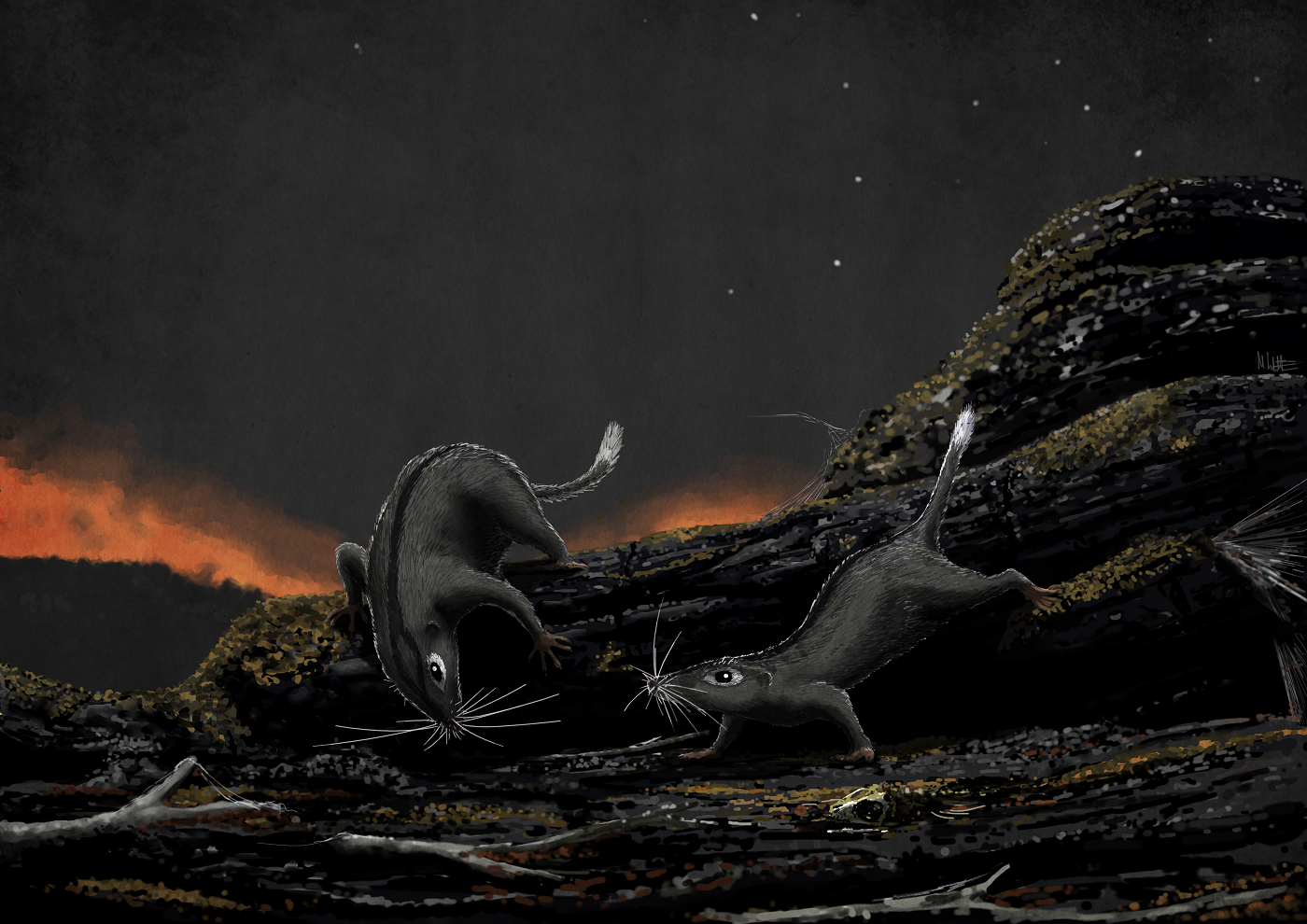 |
| Morganucodon watsoni forage for insects and spiders at night among Carboniferous limestones in early Mesozoic Wales. Empty, torn webs suggest they're having a good night, while forest fires burn in the background. Prints are available. |
Recently, I was asked to produce a reconstruction of Morganucodon watsoni for some friends (above). Being better versed in reptiles than mammals, I had to undertake a fair bit of research to bring myself up to speed on morganucodont anatomy and evolution. Turns out that reputation for being dull is entirely unwarranted: Morganucodon, its relatives, and the world they inhabited are really fascinating. Indeed, they should be bona fide fossil celebrities: Morganucodon and Megazostrodon were the first Mesozoic mammaliaforms known from anything like complete remains (albeit lots of fragments for the former, rather than a single complete specimen) instead of mere teeth and jaws. Their discovery in the mid-20th century can be seen as the start of a new era of understanding of Mesozoic mammaliaform life, and a forerunner of our now rapidly expanding knowledge of Mesozoic mammal diversity.
Initially, I wanted to write a long, detailed post about this painting and the animals it depicts, but that just won't be happening this side of 2015. But, dammit, Morganucodon is too cool to ignore completely or short-change with a 'picture of the day' post, so here's a quick-fire, from-the-hip summary of the research behind the work.
We'll start with the setting. Fossils of M. watsoni occur in British Triassic/lower Jurassic 'fissure fills' cropping out around Bristol and south Wales. These deposits represent ancient infills of caves carved into much older Carboniferous limestones, which are perhaps best known for yielding the sauropodomorph Thecodontosaurus. Fissure fill outcrops occur in multiple quarries across the southern UK and are frequently rich in fossil material, but the mammaliaforms are rare components of the fauna constrained to just a few localities. Dating the fissure fills is not easy because they contain few fossils useful for dating. Some quarries are reliably set at the Rhaetian, but they are probably not all of the same age: some may be as young as the earliest Jurassic. These include sites which contain M. watsoni fossils, which is why different texts give slightly different ages for this animal.
The upper Triassic/lower Jurassic of Europe would be an ideal holiday location for many. The desert landmass of Pangaea was in the process of breaking up, and Europe - including the southern UK - was in the process of being flooded by shallow seas. By the time M. watsoni appeared, Britain's only landmasses were small, low-lying, forested islands which, in terms of climate and general topography, would have resembled those of the Caribbean. Burned plant remains in the fissure fills indicate that the forested inlands of these islands burned on occasion, the remnants of forest fires being washed into coastal limestone caves by storms and floods. We can identify the fissure fill caves as coastal because they contain marine fossils along with terrestrial and freshwater species. It's on these limestones that I set this painting, a deliberate move to avoid another cycad-filled 'semi-arid' Triassic scene.
The island home of M. watsoni was ruled by reptiles - but not necessarily the ones you expect. Although dinosaurs were common, represented by both sauropodomorphs and theropods, the most abundant and diverse reptile group were sphenodonts. These guys deserve their own posts and paintings one day, their Mesozoic run being far more than just spreading tuatara clones across the world. Anyway, the decaying body of one of these - Planocephalosaurus - can be seen in the foreground of the painting above. As these indicate, the sphenodonts contemporary with M. watsoni weren't huge, but they still likely gave the resident mammaliaforms a hard time in competing for similar food resources. It's interesting to ponder how these animals carved up their respective ecologies to avoid direct competition with one another.
 |
| Scientists predict that, if Morganucodon were alive today, the sight of them would make grown women leap on their chairs, clutching the skirt tails in fear. |
Because art of Mesozoic mammals scurrying about at night is so rare, I wanted to capture this in my painting. The evidence for nocturnal activity in Mesozoic mammaliaforms is not as strong as you might think - it's largely based on the (questionable?) assumption that reptiles forced early mammals into nocturnal niches and the abundance of small nocturnal mammals in the modern day - but what the heck: it makes for a fun picture. It seems nocturnal mammals are often equipped with tremendous sets of whiskers, so I put similar features on my Morganucodon to help them find their way around, They may not be 'true' whiskers, in the sense of derived, mobile whiskers of modern mammals, but it doesn't seem unreasonable to imagine long, stiffened sensory hairs of some kind developing rapidly once fur was attained.
And... blast it, I'm out of time. So many other things to say, but they'll have to wait for another time. Coming soon: various theropods, festive pterosaurs, er... and probably other things too!





